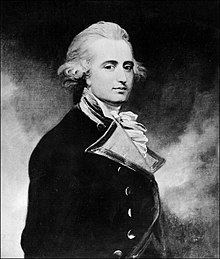John Montagu (Royal Navy officer)
John Montagu | |
|---|---|
 | |
| Born | c.1719 Lackham, Wiltshire |
| Died | 7 September 1795 (aged 75–76) Fareham, Hampshire |
| Allegiance | |
| Service | |
| Years of service | 1733–1795 |
| Rank | Admiral |
| Commands | HMS Hinchinbrook HMS Rose HMS Ambuscade HMS Tilbury HMS Greenwich HMS Bristol HMS Kent HMS Mermaid HMS Elizabeth HMS Monarch HMS Raisonnable HMS Panther HMS Terrible HMS Newark HMS Princess Amelia HMS Magnanime HMS Dragon HMS Bellona Downs Station North American Station Newfoundland Station Portsmouth Command |
| Battles / wars | |
| Alma mater | Royal Naval Academy |
| Member of Parliament for Huntingdon | |
| In office 1748–1754 | |
| Preceded by | 2 MPs |
| Succeeded by | 2 MPs |
Admiral John Montagu (1719–1795) was an English naval officer and colonial governor of Newfoundland.
Naval career
[edit]He was born in 1719, son of James Montagu of Lackham, Lacock, Wiltshire (died 1747), and great-grandson of James Montagu of Lackham (1602–1665), third son of Henry Montagu, 1st Earl of Manchester.[1] Montagu began his naval career in the Royal Naval Academy, Portsmouth on 14 August 1733.[2]
He was promoted lieutenant in 1740 and served on HMS Buckingham and, in 1744, was present at the Battle of Toulon.[2] In 1757 he was present at the execution of Admiral John Byng.[2] Promoted to Rear-Admiral in 1770, he served as Commander-in-Chief of the North American Station from 1771 to 1774.[2]
In June 1772, Montagu was involved in the Gaspee Affair as the commanding officer of Lieutenant William Duddingston, where he unsuccessfully tried to identify and have prosecuted the raiders who attacked Dudingston's ship.[3]
He was promoted Vice-Admiral in 1776 and then appointed Governor and commander-in-chief of Newfoundland.[2] Montagu captured St. Pierre and Miquelon for the British and defended Newfoundland from both French and American privateers.[2] By his swift actions he had prevented the French from capturing Carbonear and Harbour Grace.[2]
In 1783 he was made Commander-in-Chief, Portsmouth.[4] He was promoted to Admiral of the Blue in 1782 and Admiral of the White in 1787.[2]
Family
[edit]Montagu married Sophia Wroughton on 2 December 1748 and had one daughter and four sons. Of his sons, George and James became naval officers, while Edward became a lieutenant-colonel in the Royal Artillery. His daughter Sophia lived at Dale Park and the house there was constructed for her and her husband.[5]
References
[edit]- ^ Laughton, John Knox (1894). . In Lee, Sidney (ed.). Dictionary of National Biography. Vol. 38. London: Smith, Elder & Co.
- ^ a b c d e f g h Biography at Government House The Governorship of Newfoundland and Labrador
- ^ Middlekauff, Robert (2005). The glorious cause : the American Revolution, 1763-1789. New York, NY. p. 220. ISBN 0-19-516247-1. OCLC 55960833.
{{cite book}}: CS1 maint: location missing publisher (link) - ^ History in Portsmouth Archived 27 June 2015 at the Wayback Machine
- ^ Jacob M. Price, 'Smith, John Abel (1802–1871)’, Oxford Dictionary of National Biography, Oxford University Press, 2004; online edn, Jan 2008 accessed 16 April 2017
See also
[edit]
- 1719 births
- 1795 deaths
- British MPs 1747–1754
- Members of the Parliament of Great Britain for English constituencies
- Governors of Newfoundland Colony
- Royal Navy admirals
- Montagu family
- Royal Navy personnel of the War of the Austrian Succession
- People from Fareham
- Military personnel from Wiltshire
- Royal Navy personnel of the Seven Years' War
- Royal Navy personnel of the American Revolutionary War
- Viceroys in Canada stubs
- Royal Navy personnel stubs
- Great Britain MP (1707–1800) for England stubs
